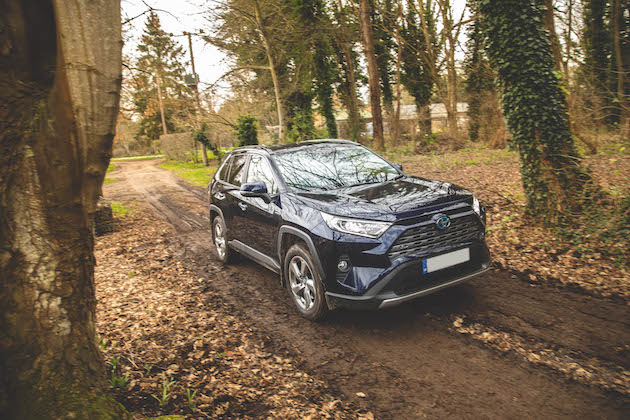News
Electric vehicles as shooting wagons – are they up to the job?
Would you like to speak to our readers? We offer sponsored articles and advertising to put you in front of our audience. Find out more. toyota RAV
toyota RAV
’With motoring turning towards the greener side, we’re definitely seeing an increase in the number of electric vehicles in our cities, towns and villages. But what does this mean for your average shooting type? Are electric vehicles as shooting wagons practical?
An eco-friendly option is likely to perform when it’s only a case of urban jaunts, but can they be sporting wagons as well? The consensus seems to be that, in some areas, electric vehicles still have a bit of a way to go.
Electric vehicles as shooting wagons
Liam Bell, a lifelong keeper and former chairman of the National Gamekeepers’ Organisation, recently put a few electric quads through their paces. He ended up sending them back. “They’ll get there,” he said, “but for the moment the torque isn’t quite there when you’ve got a heavy payload.” He also reckons the battery life can be a bit wanting. That said, eco-cars are further ahead. After a recent week with the Volkswagen W iD.4, I’d perhaps even describe myself as a convert.

VW ID.4 GTX
Not only has there been a steady surge in hybrid vehicles in the past few years — those that are powered by an engine and a battery — but full electric versions are steadily increasing in number as well.
Hybrids tend to offer all the capabilities of a normal SUV with added eco-credentials. Some hybrids simply use the petrol engine to charge the batteries for the electric motors; others incorporate the engine for drive then move over to full electric when up to cruising speed or for low-speed driving. Regenerative brakes and charging when coasting help to keep those batteries topped up. In total, you get more miles per gallon/amp, which has to be a good thing.
Greta-pleasing
But what about the next stage? Complete electric power. Electric vehicles are available from most manufacturers these days, from budget to high end, though ‘budget’ is slightly misleading as most small electric vehicles start at around £30,000. Fortunately, though, they aren’t merely little run-arounds such as the Nissan Leaf or VW iD.3 any more, and most of the popular SUVs are available in a suitably Greta-pleasing variety. So electric vehicles as shooting wagons is a possibility.
At a slightly higher price, Volvo’s popular XC40 and Audi’s Q range (with the Q4 E-Tron) are great examples of quality and comfort. Both start at around £40,000 and have similar capacities and range. Three hundred miles is quite standard for a full charge, and fast charging can be achieved in around 40 minutes. The Jaguar I-Pace is also worth a mention, but it costs a chunky £65,000. The Tesla Model X is another possibility, though I’m not sure how it would handle slippery clay ruts. Is Mr Musk a shooting man? Either way, with the Model X starting at £82,000, I wouldn’t risk it.
The Kia e-Niro is considered an entry-level option and, though it still costs more than £30,000, it’s easily big enough to load up for a weekend and achieves a range of 280 miles. The technology is improving all the time and, within the next two years, most larger SUV manufacturers will have all-electric models within their range.
Land Rover, for example, is set to launch its first all-electric in 2024 and six pure electric variants of the Range Rover, Discovery and Defender within five years.
A Land Rover spokesman said: “Over the past decade there has been enormous progress in automotive electrification, with ever-increasing battery performance and lower prices due to tax credits. For example, the early Range Rover Hybrid launched in 2013 and could travel up to 30mph for a range of up to one mile before the diesel engine seamlessly restarted. Compare that with the new Range Rover Plug-In Hybrid, launched in December 2021, which can travel up to 70 miles.”
But what about how they handle off-road? Many that I’ve driven had a low traction setting, which is a bit like low ratio. It’s essential really for getting going when things get sticky.
Interestingly, on Liam’s point about torque, I’ve generally found electric cars to be very good. There’s the obvious advantage that the power is instant. In old money, I’d say they beat petrol options but don’t have as much grunt as a diesel.
Obviously, there’s the need to charge these newfangled vehicles, but there are currently more than 42,000 charging points at over 15,500 locations in the UK. Charging also gives you a fine opportunity to sit back at a service station somewhere with the latest Shooting Times. There’s a concerted effort being made, too, with a further 7,000 charging points being installed in 2022. But is it enough?
Charging points
There are an estimated 300,000 electric vehicles on British roads, with a further 600,000 hybrids, so what if all 42,000 charging points are being used? As a full charge could take over 45 minutes, drivers should expect queues at charging stations. Perhaps you’ll need a copy of The Field too. For those who prefer to charge at home, the additional cost of installing a fast-charging dock in a rural location could prove a financial issue.
Urban locations are all well and good, but what if you’re on a longer trip? Planning a journey may require military precision to calculate mileage from charge point to charge point. To playit safe, you could take an extension cable or diesel generator in the boot. I’m only half-joking. In theory, a 150-mile round trip could be doable on a single charge, or a 300-mile stint with a charge at the other end, but it does depend how you drive.
Infrastructure is key. That will improve. It has to with the growth of electric vehicles on our roads. But that will take time and we’re not there yet.
However, Naomi Gasson, product launch manager of Kia UK, believes that modern electric vehicles address ‘range anxiety’. “We’re now seeing cars that actively improve the driving experience, particularly for drivers outside the city who cover greater distances, and on a wider variety of roads,” she says. “This means new designs and powertrain layouts to boost space and usability, a focus on sustainability and faster charging, and providing a more enjoyable drive.
“The Kia e-Niro and EV6 embrace this approach, actively encouraging people to switch to electric power, no matter their needs.”
Further hybrids I’ve been fortunate to test have been remarkably good, with pretty decent eco-credentials. All of the major manufacturers produce a hybrid and the choice is pretty extensive, from a Volvo XC90 to the new Land Rover Defender. Toyota, unsurprisingly, is pretty good at the hybrid. The RAV4 [facing page] was fun and capable, while the Highlander was promising too. Both were encouraging because they performed on and off-road and it wouldn’t take much effort to put some of that technology on the Hilux.
Following the recent announcement that the hybrid RAV4 was Toyota’s best-selling model in 2021, a spokesman explained: “Our electrification experience extends beyond 20 years. By 2030 we will have a line-up of 30 battery electric vehicles and aim to achieve eight million electrified sales globally, which will include more than 3.5 million zero-emission vehicles.”
Talking torque As Shooting Times’s car reviewer in chief, I can confirm that many of these vehicles do walk the walk and are fairly effective off-road in their full electric mode. The torque produced from the electric motors is high. Linked with a bit of witchcraft from electric drive distribution, the electric power doesn’t embarrass itself.
The Q4 E-Tron can tow up to a tonne in the 40 spec and a tonne and a half in the 50 version, which is around the same figure for most petrol/diesel-guzzling SUVs.
Some that I’ve tested have only been hindered by the overall ground clearance. Sometimes, the battery sits relatively low and, if damaged, can cost an eye-watering amount to replace. The technology is improving and I’ve seen some impressive footage of fully electric pickups taking on some serious terrain and, crucially, succeeding.
As long as the infrastructure keeps up with demand, particularly in rural areas, electric SUVs are more than capable of a sporting road trip, albeit with a bit of pre-planning. In the meantime, the hybrid seems to be the way to go. These offer a nice balance of capabilities, towing, off-road ability and good miles per gallon. The resale value for used vehicles, particularly hybrids, is currently strong and depreciation low, so the future of motoring is looking very green indeed.
Related articles
News
PETA attacks royal couple for breeding cocker pups
The Prince and Princess of Wales have faced criticism from animal rights group PETA after they had a litter of puppies
By Time Well Spent
News
Farmers launch legal review against Reeves’s farm tax
Chancellor Rachel Reeves faces a judicial review over inheritance tax reforms that could force family farms out of business
By Time Well Spent
Manage Consent
To provide the best experiences, we use technologies like cookies to store and/or access device information. Consenting to these technologies will allow us to process data such as browsing behavior or unique IDs on this site. Not consenting or withdrawing consent, may adversely affect certain features and functions.
Functional Always active
The technical storage or access is strictly necessary for the legitimate purpose of enabling the use of a specific service explicitly requested by the subscriber or user, or for the sole purpose of carrying out the transmission of a communication over an electronic communications network.
Preferences
The technical storage or access is necessary for the legitimate purpose of storing preferences that are not requested by the subscriber or user.
Statistics
The technical storage or access that is used exclusively for statistical purposes.
The technical storage or access that is used exclusively for anonymous statistical purposes. Without a subpoena, voluntary compliance on the part of your Internet Service Provider, or additional records from a third party, information stored or retrieved for this purpose alone cannot usually be used to identify you.
Marketing
The technical storage or access is required to create user profiles to send advertising, or to track the user on a website or across several websites for similar marketing purposes.





